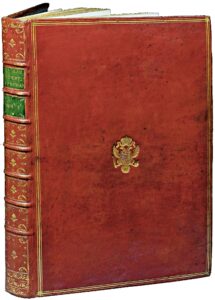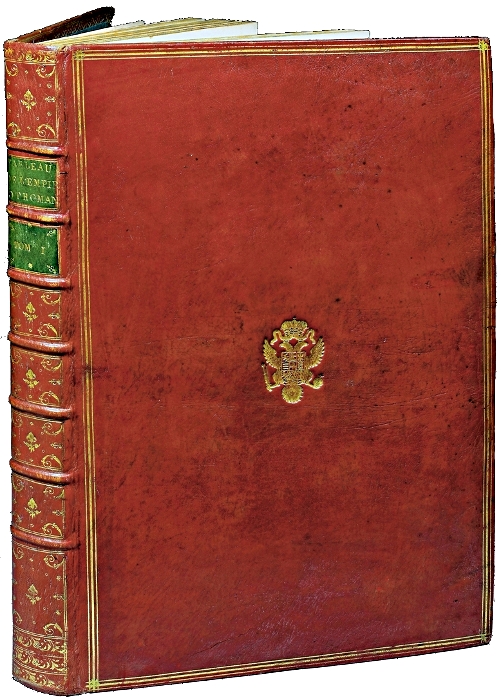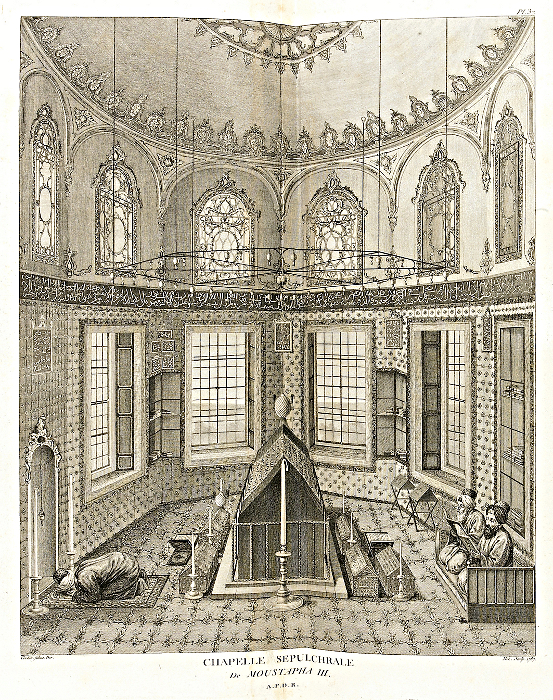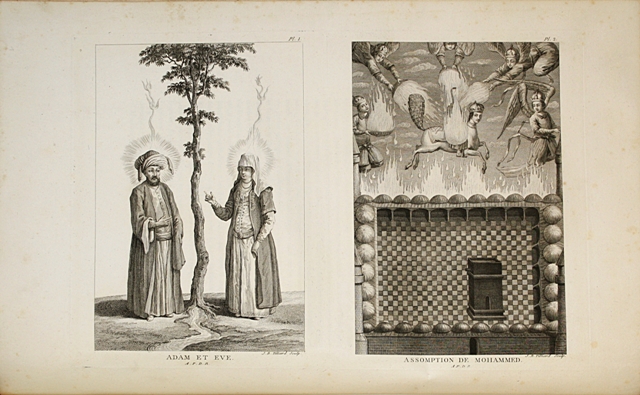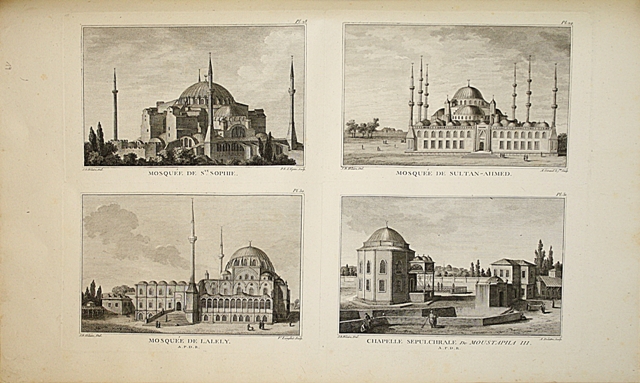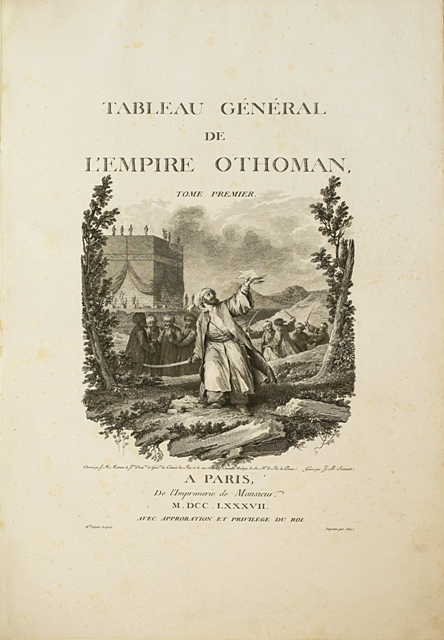Paris, de l’imprimerie de Monsieur, 1787-1790.
2 parts in 2 volumes large folio (505 x 330 mm) of: I/(4) ll. including the frontispiece, x pp., (1) l., 324 pp., (2) ll., 2 charts on double-page (marked A and AA), 1 folding-pl. (B), 1 pl. of writings (C), and 23 plates out of pagination representing 37 figures including 3 on double-page; II/ (1) l., viii pp., 357, 41 plates including 4 folding plates representing the subjects 41 to 137. Part 1 bound in contemporary red Russian young goat , triple gilt filet on borders of the covers, arms gilt-stamped in the centre, spine ribbed and decorated, green morocco lettering-pieces, inner gilt border, blue watered silk doublures and endpapers, gilt edges. Part 2 bound in contemporary green quarter-calf, spine ribbed.
First edition of this fundamental work for the understanding of the Ottoman Empire. Brunet, III, 1932 ; Cohen 763 ; Graesse 618 ; Blackmer 1164 ; Atabey 846.
« The only perfect source of information regarding the laws and constitution of the Turkish Empire ». Burckhardt
The second volume is dedicated to the Muslim religion and its rituals. It comprises details about the two holy cities and the pilgrimages, and shows a superb view of the Mecca.
« A very well executed work. The first two volumes deal with religion and Mahometan legislation. [… »] (Brunet)
« For Turkey, the excellent work of Mouradja d’Ohsson must not be omitted. The plates are beautifully executed in the line manner, and the testimony of Burckhardt to the valuable and interesting information this work contains, should alone secure it a place in every well chosen library. It is a noble work in all respects, and I give it an earnest and hearty recommendation to every collector of spirit and taste” (T. Frognall Dibdin, The Library Companion, p. 436).
Mouradja d’Ohsson, born in Constantinople, was the secretary and first interpreter of the Swedish ambassador in Constantinople. He became a chargé d’affaires in 1782 and was appointed chevalier of the order of Wasa, then plenipotentiary minister and extraordinary envoy. « He offered to write Selim II’s reign, but soon he conceived the plan of a ‘Tableau général de l’empire ottoman’, from then he devoted himself without reservation to this venture. In 1784, as d’Ohsson had managed to obtain not without difficulty a definite knowledge about uses, habits, customs, internal practices of the seraglio that had always missed to the rest of Europe, about a nation that has always been unable to become familiar with, he went to Paris to implement his rich materials. In 1788 he published the first folio volume of the ‘Tableau général de l’empire ottoman’; he published the second one the following year. The revolution that arose in France suspended his literary enterprise; he went to Constantinople […]. This work was about to be finished when d’Ohsson died in 1807, and this great project was let incomplete. » (Peignot, Dictionnaire biographique et bibliographique, 557)
A third volume, published by courtesy of the author’s son desirous to continue the project of his father, will appear 30 years later, in 1820.
The excellent and abundant illustration comprises 1 frontispiece and 68 plates representing 138 subjects, including 9 on double-page and 2 folding. A large part of the illustrations was engraved after drawings by J. B. Hilaire, the artist who went with Choiseul-Gouffier in 1776. Other plates are engraved after drawings by Moreau le jeune and Cochin.
As plates 13, 19 and 36 of the first volume were printed late, and consequently delivered after the publication of the volume, they are not present in our copy that was bound as soon as the printing of the volume ended. « As plates 13, 19 and 36 of the first part were executed after the volume, they are missing […]. » (Brunet)
« This work has not been finished. The first volume encloses besides an engraved title and 4 plates marked A, AA, B and C 40 plates numbered 1-40 (pl. 13, 19 and 36 have been executed after the volume and are usually missing), the second one pl. 41-137 ». (Graesse)
« Plates 13, 19 and 36 are missing in many copies » (Cohen).
A prestigious copy of the most important publication from the 18th century dedicated to the Ottoman Empire. The first volume that was published shortly after the death of Maria Theresa of Austria was contemporary bound in red morocco with her posthumous arms.
Maria Theresa of Austria (1717-1780) has been Holy Roman empress, archduchess of Austria, and queen of Hungary and Bohemia. She led the War of the Bavarian Succession (1740-1748) against Prussia, Bavaria, Saxony as well as France and Spain. This war made her lose Silesia. In 1745, she had her husband Francis I elected Holy Roman emperor, because she could not officially have this title. Impressed by her outdoing personality her contemporaries soon named her « the great Maria Theresa ». Then she led the war against Frederick II in the Seven Years’ War (1756-1762), in order to get back Silesia, but she failed. Maria Theresa of Austria is the mother of 16 children, including Marie-Antoinette, who married Louis XVI in 1770.
The second volume which was published at a later date was bound in a simple green quarter-calf binding.
